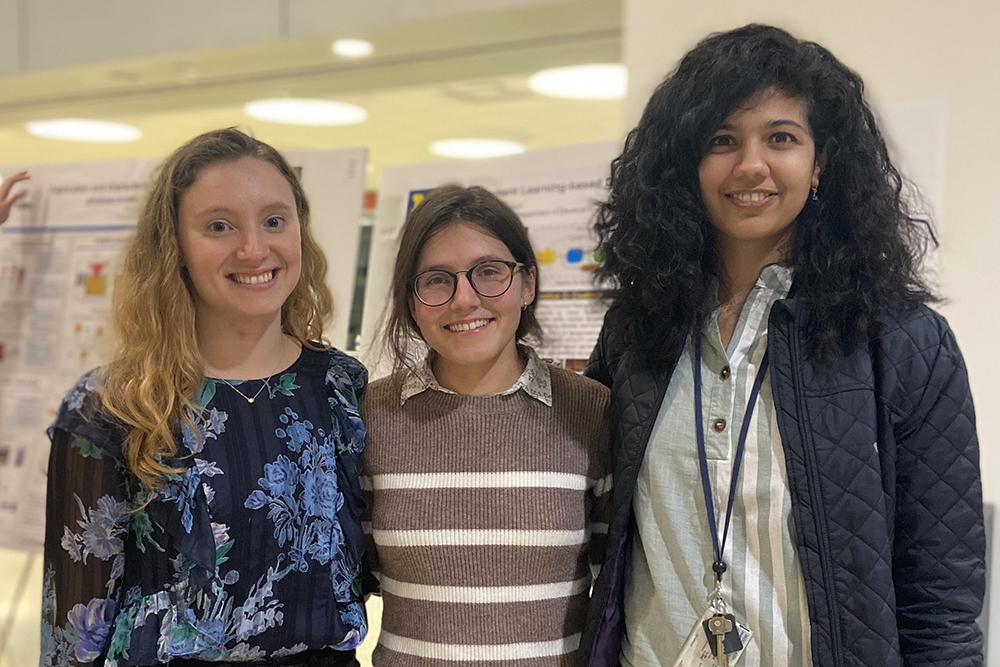LNF Poster Winners announced

The winners of the 2023 Lurie Nanofabrication Facility Poster Contest have been announced, with Physics PhD student Claire Arneson taking first, MSE PhD student Julia Lenef taking second, and ECE PhD student Yakshita Malhotra taking third.
First Place
Name: Claire Arneson
Degree/Program: PhD Physics
Advisor: Stephen Forrest, Peter A. Franken Distinguished University Professor of Electrical Engineering; Paul G. Goebel Professor of Engineering
Poster title: Solid state lighting using side-by-side white phosphorescent organic light-emitting diodes
Poster summary: Light-diodes used in lighting applications must satisfy certain requirements, including high quality color rendering and high luminous efficacy. Organic light-emitting diodes satisfy these requirements while also enabling the engineering of light-weight, flexible, and diffuse light sources. In this work, we demonstrate a method for generating white light that can be tuned from warm to cool color temperatures using yellow and blue OLEDs that are patterned in micron-scale stripes.
LNF experience: “I primarily use the LNF for photolithographic patterning and chemical processing. My favorite part of the LNF is having access to a huge range of fabrication tools that are kept in optimal condition by the fantastic LNF staff. This makes the LNF a great place to do high-quality work, while being supported by a knowledgeable and welcoming research community.”
Second Place
Name: Julia Lenef
Degree/Program: PhD Materials Science & Engineering
Advisor: Prof. Neil Dasgupta
Poster title: Tunable Sulfur Incorporation into Atomic Layer Deposition Films using Solution Anion Exchange
Poster summary: My research project combines atomic layer deposition (ALD) of metal oxides with solution anion-exchange in order to circumvent the need for hazardous H2S gas in conventional ALD metal (oxy)sulfide processing. Through this novel method, we establish a safe and scalable pathway to fabricate a variety of transition metal (oxy)sulfides, while maintaining many of the benefits of ALD, including conformality, tunable thickness and morphological control. Furthermore, we demonstrate the sulfur anion exchange process is compatible with photolithographic patterning for device fabrication and can enable uniform sulfur incorporation on high-aspect ratio surfaces. This work opens up new pathways for use of ALD in applications ranging from thin-film transistors to catalysts.
LNF Experience: “I have been a member of the LNF cleanroom since 2018. My work focuses on developing new thin-film deposition processes using atomic layer deposition for applications in semiconductor devices and catalysis. My favorite thing about the clean room is working closely with the wonderful and knowledgeable LNF staff. LNF tool engineers and staff are always accessible, helpful, and friendly, making it a great environment to work in.”
Third Place
Name: Yakshita Malhotra
Degree/Program: PhD Electrical & Computer Engineering
Advisor: Prof. Zetian Mi
Poster title: High Efficiency Green and Red MicroLEDs Using N-Polar InGaN Nanowires
Poster summary: A high efficiency, micrometer or submicron scale light emitting diode (LED) is essentially required for the emerging virtual reality and augmented reality. However, conventional LED fabrication methods suffer from a large drop in efficiency on scaling the device size. In my poster, I discussed the development of N-polar InGaN nanowire micro-scale LED emitting efficiently in the green and red spectral range. Peak external quantum efficiency values of~11% and ~1.2% is measured for LEDs emitting at 520nm and 620nm, with lateral dimensions ~750nm: consisting of just 6-7 nanowires. This efficiency value was nearly one order of magnitude higher than conventional quantum-well micro-LEDs of similar dimensions operating in this wavelength range, at the time of reporting.
LNF experience: “I have gained experience working on a lot of tools in the LNF, but my most used tool is the electron beam lithography tool. I use it to pattern tiny nanoholes on my substrate before growing nanocrystals on them. My favorite thing about working in the cleanroom is being a part of its community of researchers. There is a lot to learn and it is much easier and a lot more fun with the support from staff and senior users.”
 MENU
MENU 
